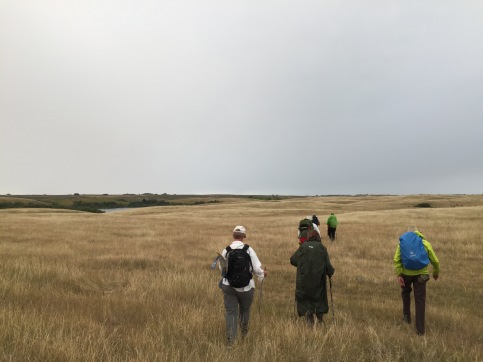
This morning I’m nursing an incision from my recent hernia surgery. But as I drink tea in Nottingham, walkers in England’s Peaks District, just a short distance away – including our friend Meredith Warren – are right now adjusting backpacks, filling water bottles, and scanning the Kinder Scout headlands. They’ll stop at the quarry where, on Sunday April 24, 1932, Benny Rothman (who arrived by bicycle to avoid police at the train) gave a rousing speech and led about 500 young people in the “Kinder Scout Mass Trespass.” That original protest might have been forgotten, except for the arrest of five of the Ramblers; Rothman got four months in prison just for his speech. The resulting public outcry led, eventually, and after much more protest, to the beautiful, wide-open British Parks that so many now enjoy, and the “Right to Roam” allowing limited public access to private land.
I climbed the 2000-foot Kinder Scout rise on a hot day last year. Oddly, the two people with me were both Canadians I had just met (we had that awkward moment in the bakery when we just had to ask, since our accents sounded so much “like home”). Between breaths we talked about whether a “Right of Responsible Access” would work in Canada. I’m convinced it would, and should: not only was much of North America an Indigenous “commons” before European contact, Settlement, and expulsion of First Nations, but for those of us who are European-background, our own histories and cultures often have clear antecedents for “everyperson’s right”. It’s ironic that the very descendants of the Irish, Scots and English who had been violently “cleared” from their commons lands by landowners so often went on to do exactly the same thing to Indigenous peoples.
We Canadians can do better. The examples are before us. National Trust’s website for Kinder Scout states “walk in the steps of the trespassers and enjoy what others fought so hard for.” We have important, historic trails on private lands on Turtle Island, too. They need limited, responsible, public access – in my upcoming book with University of Regina Press I describe our experiences walking some of these incredibly important paths. Teaching ourselves and our children that land is a common good, requiring care, will make us all healthier and happier. Reconnecting with land – our own form of Kinder Trespass – helps those of us who are Settler be better prepared as Treaty partners with those whom our ancestors also “cleared” from the lands we call home.
See my article on “Why Canadians Need the Right to Roam” at: https://theconversation.com/why-canadians-need-the-right-to-roam-100497

